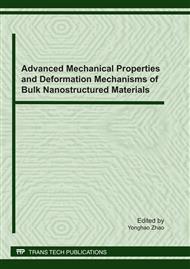p.3
p.55
p.69
p.81
p.95
p.103
p.113
p.127
Improvement of Fracture Toughness (K1c) of 7075 Al Alloy by Cryorolling Process
Abstract:
The effects of cryorolling (Rolling at liquid nitrogen temperature) and optimum heat treatment (short annealing + ageing) on fracture toughness of 7075 Al alloy are reported in the present work. The Al 7075 alloy was rolled for different thickness reductions (40% and 70%) at cryogenic temperature and its mechanical, fracture toughness properties were studied. The microstructural characterization of the alloy was carried out by using Optical microscopy and Field emission scanning electron microscopy (FESEM). The cryo-rolled (CR) Al alloy after 70% thickness reduction exhibits ultrafine grain structure as observed from its FESEM micrographs. It is observed that the yield strength and fracture toughness of the CR material with 70% thickness reduction have increased by 108% and 73% respectively, compared to the starting material. The CR 7075 Al alloy shows improved fracture toughness and tensile strength due to high dislocation density, grain refinement, and ultrafine-grain (UFG) formation by multiple cryorolling passes. The CR samples were subjected to short annealing for 5 min at 190 0C, 170 0C and 150 0C followed by ageing at 160 0C, 140 0C and 120 0C for both 40% and 70% reduced samples. The combined effect of short annealing and ageing improves the fracture toughness, tensile strength, and ductility of cryorolled samples, which is due to precipitation hardening and subgrain coarsening mechanism respectively. The scanning electron microscopy (SEM) fractographs of the Al 7075 alloy samples reveals that starting bulk Al alloy specimens is fractured in a total ductile manner, consisting of well-developed dimples over the entire surface and dimple size got decreased continuously for cryorolled specimens at different percentage of thickness reduction (40% and 70%) as observed in the present work.
Info:
Periodical:
Pages:
81-94
Citation:
Online since:
May 2011
Authors:
Price:
Сopyright:
© 2011 Trans Tech Publications Ltd. All Rights Reserved
Share:
Citation:


